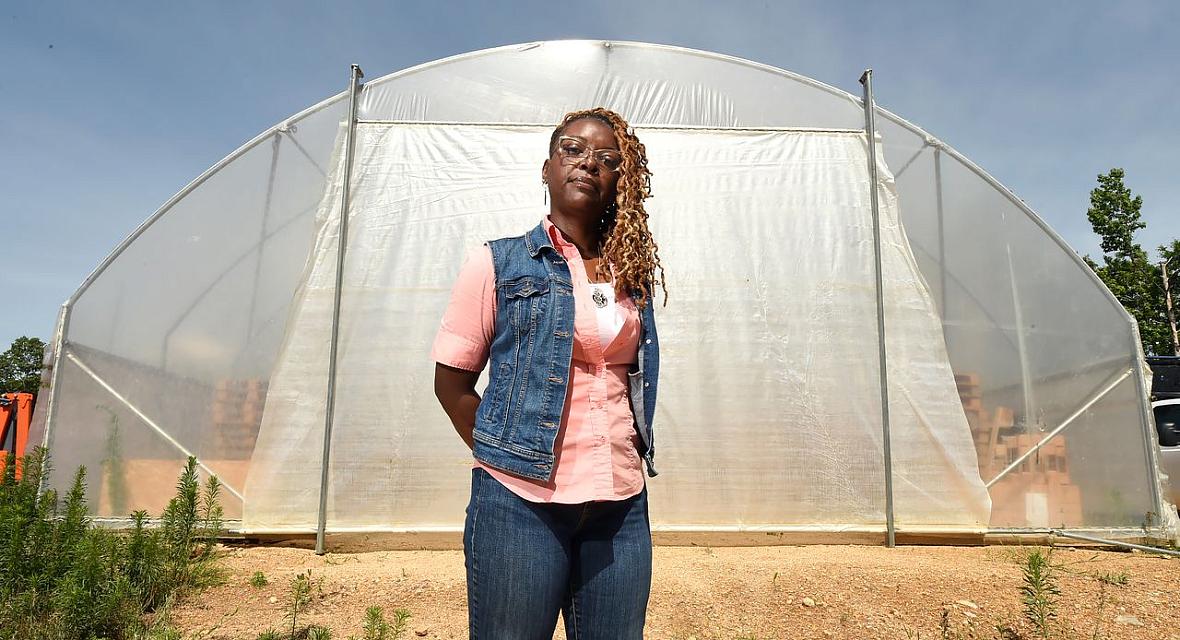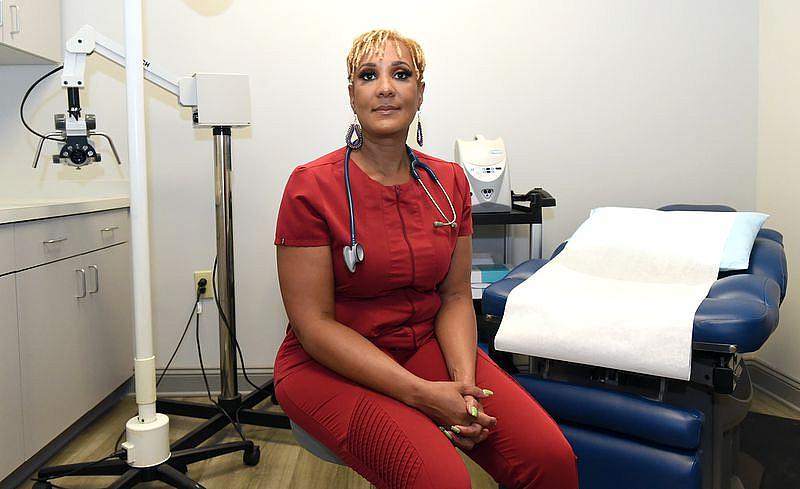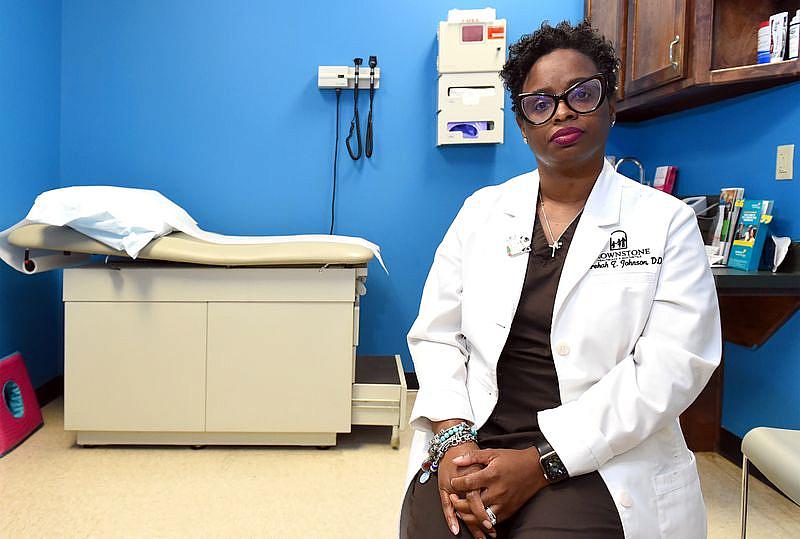As the South struggles with high hysterectomy rates, Black women lead the fight for change
Amy Yurkanin reported this story while participating in the USC Annenberg Center for Health Journalism’s 2022 Impact Fund for Reporting on Health Equity and Health Systems, which provided training, mentoring, and funding to support this project.
Other stories include:
Program increases treatment options for rural Alabama women with fibroids

Kristy McKinney, a former Birmingham police officer, had a hysterectomy after experiencing abdominal pain. Later she learned the hysterectomy was unnecessary and pain was related to a back injury, not uterine fibroids.
Joe Songer
In 2016, pain began rippling through the abdomen of Birmingham Police Officer Kristy McKinney.
More than a dozen years on duty had exposed her to all kinds of physical stress. McKinney had been in three car accidents and carried nearly 20 pounds of gear around her waist on patrol. But this didn’t feel like “gun belt back,” a common police malady caused by the downward tug of heavy equipment.
It felt like contractions. McKinney made an appointment with her OB/GYN.
“She did her exam and said I had 3 uterine fibroids the size of golf balls,” McKinney said. “It shocked me because I had never heard of uterine fibroids in my family.”
Uterine fibroids are noncancerous tumors that grow in and around the uterus, feeding off hormones. They are very common, appearing in up to 70 percent of women by age 50.
When they do cause symptoms, they can be serious – everything from pain to excessive bleeding. For Black women, fibroid symptoms often start earlier and become more severe. They are the most common reason women get hysterectomies, and the root of a racial disparity that makes Black women twice as likely as white women to have their uteruses removed.
McKinney’s doctor said she could remove the fibroids surgically, sparing her uterus, but they might come back. Her sister and mother had both been diagnosed with cancer and the prospect of living with growing tumors inside her body worried the officer.
“When she said that, I thought, ‘Oh my God, I’m set up for cancer,’” McKinney said. “I just knew then I’m on my way to ovarian cancer. There’s something wrong down there.”
A hysterectomy seemed to be the safer and more permanent solution, but McKinney, then 36, paused at the thought of losing her ability to have children. She was in the middle of a divorce and in the end, her pain overrode those concerns.
She had her surgery in early 2017 and spent six weeks recovering. On her first day back at work, an explosion of pain erupted below her stomach as she twisted to step out of a marked SUV. A neurologist eventually diagnosed an injury to her spine from on-the-job traffic accidents.
The hysterectomy hadn’t been necessary. Now McKinney found herself grappling with mood swings and hot flashes complicated by persistent pain and a budding dependence on opioid medication. It’s difficult to pinpoint the effects of removing her uterus on her health, McKinney said.
“I was in a battle with myself mentally on how strong I could be to go through this situation,” McKinney said. “My anger got exacerbated because I was just mad. I was at the point where I didn’t want to talk to people because I knew I would be snappy.”
At her lowest point, McKinney said she fought off suicidal thoughts.
“I told my husband, I literally felt the angel of death caressing me in my sleep that night,” McKinney said.
A neglected disease
Fibroids can grow slowly and painlessly during a woman’s reproductive years and vanish when menopause stops the flow of hormones. Or they can multiply and bulk up, causing pressure and heavy bleeding. The tumors are not deadly, but they can have serious consequences, including infertility, anemia and even kidney damage.
For decades, doctors defaulted to hysterectomy to treat fibroid symptoms. That’s changing as patients push for more awareness and a wider range of treatment options.
A bill filed last year in Congress would increase research funding for fibroids, which have long been neglected by scientists focused on medical treatment. In 2019, they garnered only $17 million in funding from the National Institutes of Health, putting them in the bottom 50 of 292 funded conditions. An overview of available research by the federal Agency for Healthcare Research and Quality found a “remarkable lack of high-quality evidence supporting the effectiveness of most interventions for symptomatic fibroids.”
LaToya Dwight, founder of the Fibroid Pandemic in Atlanta, learned she had fibroids when she went to her gynecologist to have her IUD removed, a routine procedure that became complicated by growths that hid the birth control device. Her doctor ordered an ultrasound to find it.
They found the IUD and several large fibroids. Her doctor recommended hysterectomy and tried to schedule it the same day. Dwight had never heard of fibroids when she received the diagnosis.
“I came in to get my IUD replaced, which is extremely routine, but I’m leaving with the recommendation to get a hysterectomy,” Dwight said. “I left there upset, clueless and feeling like my body had betrayed me. I got in the car and cried so badly.”
The U.S. Food and Drug Administration approved the first drug to treat heavy bleeding from uterine fibroids in 2020. Researchers still don’t know why Black women have more tumors than their white counterparts or the frequency of fibroids in other groups such as Asians and Latinas.
Dr. Warner Huh, chair of the department of obstetrics and gynecology at the University of Alabama at Birmingham Heersink School of Medicine, said the condition doesn’t generate the same kind of urgency as other gynecological problems, even though it’s very common and often leads to surgeries.
“It’s not cancer,” Huh said. “Women usually don’t directly die from fibroids. And I think that people just think there’s a solution. It’s called a hysterectomy. Just do the hysterectomy.”
A complicated history
Dr. Mia Cowan grew up in Birmingham, but did her medical training in Milwaukee, Wis. As an obstetrician and gynecologist, she built her practice by traveling around central Alabama, often providing second opinions to women who had been told they needed hysterectomies. (Joe Songer for al.com).Joe Songer
The legacy of unequal care in women’s health has deep roots in Alabama, where Dr. James Marion Sims performed brutal experiments on enslaved women. He developed techniques to repair the damage from childbirth, but often operated without anesthesia so slaves could return to the fields and produce more children.
Sims died in 1883, but racism in gynecological care lived on. As recently as the 1960s and 1970s, Black women in Alabama often received unnecessary and unwanted hysterectomies and sterilizations. Environmental activist Catherine Coleman Flowers grew up watching her mother protest the practice after doctors removed her uterus without permission. In 1973, the Southern Poverty Law Center sued on behalf of Mary Alice and Minnie Lee Relf, two Black girls in Montgomery who were involuntarily sterilized when they were just 14 and 12 years old.
Dr. Mia Cowan, an OB/GYN in Birmingham, said Black women still often receive lower quality care. She attended medical school and did her residency in Milwaukee, then moved back down to her hometown, Birmingham, to work at Cooper Green Mercy Hospital, providing medical care to some of the area’s neediest patients. In 2010, she began her own practice and started traveling to outlying communities to treat patients in areas without specialists.
“I did notice that I had a lot of patients come to me who didn’t know why they had a hysterectomy,” Cowan said. “I even had a patient come to me who had a hysterectomy for abnormal pap smears, and they had a hysterectomy, but they left her cervix in, which makes no sense.”
She often found herself offering second opinions to women told they needed hysterectomies.
“Probably about half the time, I agree with the initial recommendation of a hysterectomy,” Cowan said. “If you are 100 percent sure you don’t want children and your symptoms are affecting your quality of life, then I will send them back to their gynecologist for a hysterectomy. But if someone says, they have a 12-centimeter size uterus, a few small fibroids and some heavy bleeding and my doctor said I need to have a hysterectomy. I’m like, I don’t agree with that, let’s try other treatment options.”
Last year, the American College of Obstetricians and Gynecologists updated its fibroid treatment guidelines for the first time since 2008 to prioritize medication and less invasive procedures and make hysterectomy a treatment of last resort.
“That is definitive treatment, but that is not the first line of treatment,” Cowan said. “Sometimes people don’t need surgery at all. I can offer them medications, including hormonal birth control options. There are also new medications out there to treat uterine fibroids causing abnormal bleeding specifically and there are several minor outpatient procedures that can treat symptoms.”
Access to care
In Alabama, 33 out of 67 counties don’t have practicing OB/GYNs, according to the Alabama Department of Public Health. That means primary care doctors handle routine screenings and prescribe medications. Women who need surgery or other procedures usually performed by gynecologists might have to drive an hour or more to receive care.
That absence is perhaps most felt in the Alabama Black Belt, a rural stretch of south Alabama which has a shortage of hospitals, dentists and most specialists – including gynecologists. That’s where Dr. Ankreah Johnson grew up, in the small town of Marion, where she was raised by a pastor and a teacher.
Her family has lived in Alabama a long time, but most of her grandmother’s siblings left for Fort Wayne, Ind. Despite the distance, all seven sisters remained connected, and all developed the same problem: uterine fibroids. Six of them had hysterectomies.
“My grandmother was the only one who decided to not have a hysterectomy, and as fate would have it, she got ovarian cancer,” Johnson said.
The family history of fibroids weighed heavily. It felt like a time bomb constantly ticking in the back of her mind, even during the joy of childbirth.
Dr. Ankreah Johnson at Brownstone Healthcare and Aesthetics in Trussville, Alabama. (Joe Songer for al.com).
“When I went in for her delivery as a c-section, I asked do you see any fibroids?” Johnson said.
Her symptoms appeared a few years later. The doctor who operates clinics in Birmingham and Trussville had an ablation in 2020, a non-surgical treatment that strips the lining of the uterus but keeps it in place. She and her gynecologist have decided to wait until her symptoms get worse to consider surgery – an option that might not have been offered in the past.
“I don’t think my mom or aunts were given the opportunity to just go with it as long as you can, like I’m doing,” Johnson said. “It’s kind of a watchful waiting.”
But the waiting creates space where questions emerge. Johnson has annual ultrasounds to check on the size of her fibroids. This year, the number of tumors inside her uterus had doubled, a discouraging setback.
“What am I doing? Is it something that I’m eating? Is it something that I’m around that is causing them to grow?” Johnson said.
Her doctor said she didn’t need a hysterectomy yet. Not until her pain or bleeding had increased.
“She said, otherwise, you just continue to live with it,” Johnson said. “However, that’s a hard thing to carry. Knowing that your uterus has all these benign tumors and that they continue growing.”
Low-value procedure
Researchers from Johns Hopkins University have designated hysterectomy as a low-value procedure, which means it provides little benefit and carries a high risk of harm. Although the surgery can be life saving for people with cancer and genetic markers for cancer, about one in 10 patients who undergo the surgery will develop complications. Research in the last 15 years found higher rates of heart disease among women who had hysterectomies.
Shayla Compton of the Center for Black Health and Equity in North Carolina said she has concerns about the link between hysterectomy and heart disease – a leading killer of Black women. A fibroid patient herself, her family’s experience shows that removing the uterus doesn’t always lead to better health.
“That is something I’ve seen first-hand with my mother,” Compton said. “Within six months of having a hysterectomy for uterine fibroids, she had a severe heart attack. She survived, but that was one of those things we always had questions about.”
Although new techniques and treatments have emerged to treat fibroids, they remain out of reach for many women. Some treatments may only be available in big cities or among women with private health insurance. A procedure like uterine fibroid embolization, which requires high tech imaging and specialists in interventional radiology, is only available in four Alabama cities.
Spending on hysterectomies and other gynecological surgeries has decreased since 2010, according to data from the Alabama Medicaid Agency. Physicians are shifting away from surgery in many non-cancer cases. Black patients remain overrepresented in hysterectomy spending, receiving about 34 percent in 2019, even though they represent about 27 percent of the state population.
The U.S. Centers for Disease Control and Prevention tracks the number of total abdominal hysterectomies performed in hospitals by state, which shows higher rates in several Southern states. Those figures don’t include all hysterectomies – less-invasive and robotic surgeries may not be included. Despite the emergence of new surgical techniques, abdominal hysterectomies remain the most common type.
Dr. Warner Huh, chair of the department of obstetrics and gynecology at UAB Heersink School of Medicine, said some women in Alabama who don’t have receive regular care may end up with fibroids too large to remove with robotic surgery. Many adults in the state don’t have health insurance or live in areas with few doctors. They may not receive any treatment until severe symptoms send them to the emergency room.
“A lot of these women have excessive vaginal bleeding or really heavy period to the point where patients have to be hospitalized with such severe anemia that they need blood transfusions,” said. “I’ve taken care of hundreds of women like that in my 20-plus-year career here at UAB where I’ve had patients transfer in with such severe fibroids and such severe bleeding that they basically have to have an emergency hysterectomy, so they don’t bleed to death.”
Advocates have pushed for greater awareness of less-invasive treatments, but also for more research into the cause of fibroids. That was neglected for decades as researchers focused on cancer and other gynecological conditions. Advocates hope that research could produce a non-surgical cure.
So far, it’s in its infancy. Dr. Evan Myers, a professor of obstetrics and gynecology at Duke University School of Medicine, said some early studies point to a potential link to collagen, a protein found in skin, cartilage and bones. That could explain the racial differences – overproduction of collagen causes keloids, excess scar tissue that also affects Black patients more often than whites.
“How much of it is that women’s health research in general tends to be underfunded?” Myers said. “How much of it is the perception that you can cure it with hysterectomy? How much of it is unconscious bias, because typically conditions that have a disparate impact on Black women or other minorities don’t get as much attention? It’s really hard to tease out how much of it is bias and access and how much of it is that the disease tends to be more severe among Black women.”
Changing treatment
Black women are driving efforts to improve care for fibroids. Doctors and patient advocates have pushed to provide more information about non-hysterectomy treatments.
Tanika Valbrun started the White Dress Project in 2014 and wrote legislation to designate July as Fibroid Awareness Month. The organization has pushed for more money for research and for increased education about the condition.
Doctors typically ask female patients about their periods, but they may not be asking the right questions. Someone who has always had extremely heavy and long periods from fibroids might not know their experiences are abnormal or unhealthy, Valbrun said. Instead, doctors should ask more detailed questions about pad and tampon use.
The shame associated with heavy bleeding can keep some women from seeking care, Valbrun said.
“There’s so much stigma,” Valbrun said. “For some reason, we’ve been told you shouldn’t talk about these things.”
Valbrun said too many patients are still being offered hysterectomy instead of more conservative treatment. Sateria Venable, executive director of the Fibroid Foundation, had that experience when she was first diagnosed with fibroids at age 26.
“They recommended a hysterectomy, so I quickly left that doctor,” Venable said. “Because at the age of 26, I thought that was absolutely ridiculous for anyone to suggest that without asking me any other questions.”
In Birmingham, after McKinney’s surgery and back injury, she left law enforcement and grew frustrated with pain management. She began to push back more against her doctors and eventually weaned herself off opioids by using cannabis.
McKinney said she now wishes she had done more research before surgery.
“There are treatments I could have tried before I took my uterus out,” McKinney said. “That could have possibly helped me not go through the hot flashes and the hormonal imbalance and the mood swings I went through while I was also on the pain medication. That put me through a real dark time in my life.”
Amy Yurkanin reported this story while participating in the USC Annenberg Center for Health Journalism’s 2022 Impact Fund for Reporting on Health Equity and Health Systems, which provided training, mentoring, and funding to support this project.
[This article was originally published by AL.]
Did you like this story? Your support means a lot! Your tax-deductible donation will advance our mission of supporting journalism as a catalyst for change.

